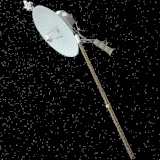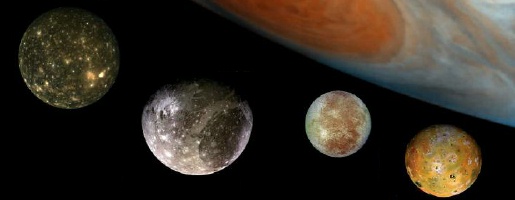 |
||
|
Jupiter's
Galilean moons against a backdrop of the Great Red Spot.
|
||
| THE MOONS OF JUPITER | ||
| Jupiter has 60 satellites. Distinguishing between their orbits they fall into six main groups. There are the Galileans (4), the innermost satellites (4), and further out: the Himalia group (4) and three groups of irregular and retrograde orbiting moons with 7, 9 and 10 members. The Galilean satellites are large and planet-like, whereas the smaller moons are rather inconsequential. The small satellites have more in common with asteroids. | ||
 |
||
| Jupiter's innermost moons (left), Metis, Adrastea, Amalthea, and Thebe, shown at correct relative sizes. | ||
 The orbits of Jupiter's moons. |
||
| The inner moons | ||
| The four inner satellites of Jupiter are all irregular in shape. They are too small and dense to have formed as spheres or to have separated into layered bodies. They are exposed to especially high levels of radiation and are bombarded by protons and electrons generated by Jupiter's magnetosphere. | ||
| All have low eccentricity (near-circular) orbits. They also orbit on a near-level plane, and their paths are not greatly tilted or inclined with respect to Jupiter. | ||
 Map of Jupiter's ring system and inner moons. |
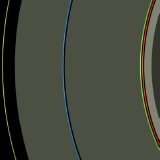 The orbits of Jupiter's inner moons. |
|
| Not much is known about Jupiter's inner satellites. However, even though they are not revealed in great detail, Galileo images have greatly increased our knowledge of their shape and surface properties. | ||
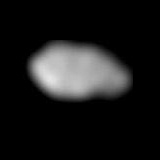 Galileo image of Jupiter's innermost moon, Metis. |
 Galileo image of Adrastea |
|
| More about Metis | ||
| More about Adrastea | ||
| It has been suggested that the inner moons Metis and Adrastea may act as shepherds, their gravity preventing Jupiter's main ring from dispersing. It is also possible they supply the material from which it is formed. Amalthea and Thebe have been identified as the source of Jupiter's outer rings. | ||
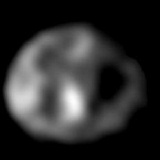 Galileo image of Thebe. |
 Voyager 1 view of Amalthea, the reddest moon in the Solar System. |
|
| The Galilean moons | ||
| The four largest moons (Io, Europa, Ganymede and Callisto) are known as the "Galilean" satellites because amongst the first to see them was the Italian Galileo Galilei. He is normally credited with their discovery, though it was the German astronomer Simon Marius who named them. | ||
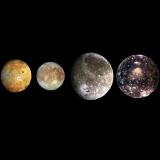 The Galilean moons Io, Europa, Ganymede, and Callisto. |
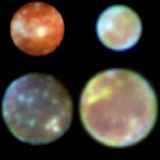 The best ground-based view of the Galilean moons is provided by the Hubble Space telescope. |
|
| At first Galileo saw three (a fourth later) points of light either side of Jupiter. | ||
| Galileo wrote: "I therefore concluded, and decided unhesitatingly, that there are three stars in the heavens moving about Jupiter, as Venus and Mercury round the Sun; which was at length established as clear as daylight by numerous other subsequent observations". | ||
| In realising that these specks of light were revolving about Jupiter, Galileo made one of the most important discoveries of the Renaissance. The orthodox view of the Universe had been the "Ptolemaic" (after Ptolemy of Alexandria) or geocentric system which placed the Earth at the centre of the universe. Galileo was able to demonstrate that not all bodies moved about the Earth and that it was not the centre of the universe. The geocentric view was closely bound with religious dogma and Galileo faced the Inquisition for upholding the "Copernican" or heliocentric view that the Earth moves around the Sun. | ||
| Due to their brightness and the ease with which they are observed, the orbital characteristics of the Galilean satellites have been studied in depth and are known with some accuracy. Indeed, the Galilean satellites can be seen through binoculars. | ||
| However, even with the largest telescopes, the surfaces of the Galilean satellites seen from Earth are not clear. In the 1960's a series of maps were made by the French astronomer Audouin Dollfus. He perceived surface markings on each of the moons. Even with the benefit of Voyager images, it is difficult to relate the features he identified to the actual surfaces. | ||
|
|
||
| They were revealed as worlds in their own right, exhibiting an array of geological phenomena both ancient and modern. There are surfaces retaining the intense impact record of the early Solar System, highly fractured and dislocated surfaces, and those where all but the most recent landscapes are effaced by volcanic processes. | ||
| Probably the most important disclosure of the Voyager mission was that tidal heating could keep small worlds geologically alive. Tidal forces could provide enough energy to keep a planet's interior molten long after the decay of radioactive materials is over and its own internal heat has been expended. The gravitational pull between the moons and Jupiter creates "body tides" whereby the whole body of the moon is distorted. These tides are felt most strongly by Io. When Io lies directly between Europa and Jupiter, it is pulled by both in opposing directions. As Europa overtakes Io, the alignment changes, the pull diminishes and Io relaxes. | ||
 The orbits of the Galilean moons |
||
| In the revolution of four large moons about Jupiter, Galileo saw a miniature solar system. With Voyager it has become apparent that the moons of Jupiter mirror another property of Solar System. Denser materials have tended to accumulate nearer Jupiter (as with the Sun) and volatile liquids and gases further from it. | ||
| The most recent mission to the moons of Jupiter is the Galileo mission, which has not only provided the highest resolution pictures ever taken of the surfaces of the moons, but has also made a variety of other measurements. Our understanding of the Jovian moon system has improved dramatically since the Voyager visits. | ||
| Io | ||
| Io is squeezed and reforms like a rubber ball. The stresses it experiences generate the heat that melts its rocky interior and fuels its giant volcanic plumes. Further from Jupiter, the effect is weaker. With distance, the Galilean satellites exhibit a progressively lesser amount of surface modification by internal processes. | ||
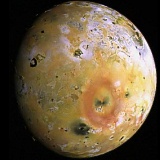 Io |
||
| More about Io | ||
| Europa | ||
| Europa has few craters and appears resurfaced by various fluids and mobile ices. Evidence of surface movement survives in its complex fracture network. Though not as violently disrupted as Io it may have ceased to be active, geologically speaking, only a short time ago. Tidal heating within Europa may still preserve a liquid ocean beneath its chilled outer crust. | ||
 Europa. |
||
| More about Europa | ||
| Ganymede | ||
| The third Galilean moon, Ganymede, is a mixture of terrains. In parts, the grooved and fractured surface mimics Europa's. Elsewhere it preserves craters from an epoch of dense meteoritic bombardment early in its history. | ||
 Ganymede. |
||
| More about Ganymede | ||
| Callisto | ||
| Callisto completes the trend. It shows little sign of resurfacing, just the collapse of steep crater flanks here and there. There is no significant movement in the crust. No volcanism can be discerned. Callisto is dominated by craters. It has large complex craters, the distribution of which indicate that it was struck by meteorites originating from within the Jovian system and from without. The size range and preservation state of craters on Callisto indicates that it has been inactive for a very long time indeed. | ||
 Callisto. |
||
| The outer moons | ||
| Very little is known about the outer moons of Jupiter. They are very faint, having visual magnitudes (brightness from Earth) of between +15 and +20. Pluto is brilliant by comparison with a visual magnitude of +14. | ||
| The outer satellites of Jupiter fall into four groups. The Himalia group which comprises Himalia, Leda, Lysithea, and Elara orbit Jupiter at about 11 million km. They all have a highly inclined orbit (about 30o) and similar orbital eccentricity (about 0.15). All of the outer satellites were discovered after 1900, and many of them only in the last few years. They remain, even in the best telescope images, no more than points of light and their most basic properties are not well known. Their sizes are measured with an accuracy of only 20% to 30%. | ||
 The orbits of the inner group of Jupiter's outer moons (left). |
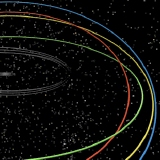 The orbits of the outer group of Jupiter's outer moons (right). |
|
| The outermost moons, Pasiphae, Ananke, Sinope, and Carme, orbiting at about 22 million kilometres from Jupiter, have very inclined retrograde orbits. These vary between 147o (Ananke) and 163o (Carme). The outer group also have a greater orbital eccentricity. Pasiphae's orbit has an eccentricity of 0.4, tracing the most elliptical path of Jupiter's moons. | ||
| These irregular satellites could be captured asteroids, or perhaps the remains of single large asteroid or comet which was captured by Jupiter and broken apart by tidal forces. | ||
| Jupiter's other moons | ||
| With more powerful telescopes and by combining images taken over a period of time, astronomers have over the last few years found many more small moons orbiting Jupiter. In the early part of 2003, twenty new satellites were discovered bringing the total number of known satellites to sixty. In the discovery images the moons are faint, fuzzy blobs of light; they are so hard to see that they went undetected by Voyager when the spacecraft made its Jupiter flyby and was in the vicinity. | ||
| Very little is known about the small irregular satellites of Jupiter. They orbit far from the planet, have orbits which are highly inclined with respect to the plane of Jupiter's equator, and trace elliptical paths. Their orbits are very different to those of the Galilean moons and the inner satellites, which have virtually circular orbits in the plane of Jupiter's equator. Callisto, the outermost of the Galilean satellites, orbits just 1.9 million kilometres from Jupiter. Most of the orbits of the irregular satellites are located 20 to 25 million kilometres from Jupiter. With the exception of S/2003 J20 the irregular satellites orbit retrograde, in the opposite direction to Jupiter's rotation. | ||
| The orbits of the Jupiter satellites discovered in 2003 are still preliminary and further observation will be required to verify them. Jupiter's booming satellite population is almost certain to grow. Many other suspected moons have been found in digital telescope images but are unconfirmed. The discovery of such tiny bodies requires careful and continued observation to learn their orbits and not to loose them after the initial discovery. | ||
| Nothing is known of the moons' surfaces, and apart from an estimate of their diameter, nothing of their physical characteristics- mass, density, or composition. | ||
| They are very likely to be captured asteroids, caught by Jupiter's gravitational pull. Although astronomers are unsure of the exact mechanism of capture, it is suggested that early in Jupiter's history the planet possessed a 'bloated' atmosphere far larger than its present day atmosphere, and which could have exerted drag and eventually captured solar orbiting asteroids. | ||
| Researchers comparing the orbital properties of the moons have noticed that some of the moons have similar orbits and that is possible to distinguish families of moons based on orbital characteristics. It is speculated that these dynamical groups were created with the break up of a larger asteroid, not in a collision with another asteroid, but owing to the stress of the encounter with an extended planetary atmosphere. | ||
| The moons are named after goddesses and nymphs of Greek mythology associated with Zeus. Names ending in 'e' are chosen for moons with retrograde orbits. Small moons with prograde orbits (e.g. Leda, Himalia) are given names ending in 'a'. | ||
|
|
||
